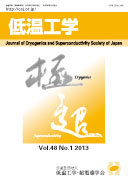All issues

Volume 48, Issue 2
Displaying 1-6 of 6 articles from this issue
- |<
- <
- 1
- >
- >|
Preface
-
Eiji MUROMACHI2013Volume 48Issue 2 Pages 59
Published: February 25, 2013
Released on J-STAGE: April 02, 2013
JOURNAL FREE ACCESSDownload PDF (659K)
Review Articles
-
Susumu SHIMAMOTO, Hideo NAKAJIMA, Yoshikazu TAKAHASHI2013Volume 48Issue 2 Pages 60-67
Published: February 25, 2013
Released on J-STAGE: April 02, 2013
JOURNAL FREE ACCESSCryogenic structuralmaterials are an essential element to fulfill the performanceof superconducting coils for fusion reactors. In this field, there was no specialized steel and mechanical properties data at 4 K until 30 years ago when the Japan Atomic Energy Agency (JAEA) started the development of the Tokomak fusion reactor. JAEA set a target of mechanical characteristics which could satisfy requirements for the coil structure at 4 K and equipped evaluation facilities at 4 K for tensile tests, fatigue tests and so on. At the same time, JAEA initiated collaboration with the steel industries in order to realize new cryogenic structural materials and carried out mechanical evaluation tests at 4 K on numerous samples which were supplied from the industries. There are two areas: a coil case and a conductor jacket for forced flow conductor. The former requires large forging products and thick hot-rolled plates for the coil case. The latter is influenced by heat treatment at approximately 650 °C and more than one-hundred hours to produce Nb3Sn superconducting material at the final stage. This is a unique issue for the jacket. Finally, both the case and the jacket material for construction of the ITER are now being supplied from the Japanese industries through JAEA. In addition, JAEA contributed to the standardization of these testing methods at 4 K in Japanese industrial standards (JIS). Furthermore, JAEA supported the establishment of a design code for the structure of superconducting coil for a fusion facility at the Japan Society of Mechanical Engineers (JSME). This paper describes the more than 30-year history of the development of cryogenic structural material.View full abstractDownload PDF (1502K) -
The History and Future Prospect of its Demand and SupplyHiroshi BANDO, Yuichi TSUBOI, Kazuhiko MORI2013Volume 48Issue 2 Pages 68-76
Published: February 25, 2013
Released on J-STAGE: April 02, 2013
JOURNAL FREE ACCESSA review is presented of how helium has been produced, supplied and consumed domestically in Japan and worldwide. In the majority of fields of helium consumption, recovery or recycling is not common due to cost issues. Historically, fields of end-use as well as production and supply of helium resources have been heavily affected by federal legislation in the United States. Considering the declining production and diminishing reservoir in the United States and rather unstable operation of resources in other countries in the future, at least domestically, development of low-cost helium recovery apparatuses and strategic promotion of helium recycling as performed for rare metals is crucial.View full abstractDownload PDF (1188K)
Focused Review
-
Toward an Innovation in Information and Communications TechnologyHirotaka TERAI, Taro YAMASHITA, Shigehito MIKI, Kazumasa MAKISE, Zhen ...2013Volume 48Issue 2 Pages 77-82
Published: February 25, 2013
Released on J-STAGE: April 02, 2013
JOURNAL FREE ACCESSThe superconducting single-flux-quantum (SFQ) circuit is the ultimate energy-efficient digital circuit technology. The SFQ circuits are very promising for applications not only to huge systems such as supercomputers and/or high-end routers but also to the signal processing circuit operating with superconducting detectors. We introduce the recent progress in the SFQ circuit technology focusing on the application combined with superconducting single-photon detectors (SSPDs). The four-pixel SSPD array was successfully operated with the SFQ signal processing circuit in the 0.1 W Gifford McMahon refrigerator.View full abstractDownload PDF (1635K)
Fundamental Cryogenic Engineering
-
— Finite Element Method and Boundary Element Method —Hiroshi UEDA, Atsushi ISHIYAMA2012Volume 48Issue 2 Pages 83-94
Published: February 25, 2012
Released on J-STAGE: April 02, 2013
JOURNAL FREE ACCESSAs methods of electromagnetic field analysis, the finite element method (FEM) and the boundary element method (BEM) have been widely used. The FEM is suitable for analysis of a complicated region which includes non-linear materials. On the other hand, the BEM is useful for analysis of infinitely extending fields. This time, the basics of FEM and BEM, and the boundary conditions of the electromagnetic field are explained.View full abstractDownload PDF (889K)
Original
-
Takuya YOSHIMURA, Toshiya DOI, Takemori IZUMI, Takumi OZAKI, Akiyoshi ...2013Volume 48Issue 2 Pages 95-101
Published: February 25, 2013
Released on J-STAGE: April 02, 2013
JOURNAL FREE ACCESSWe fabricated Bi2Sr2Ca2Cu3O10 (Bi2223) thin films on SrTiO3 (100) substrates using a DC magnetron sputtering method. From X-ray diffraction measurements (θ-2θ and φ-scan), the as-grown film had a Bi2223 single phase and a biaxial crystal orientation. The critical temperature of the as-grown films was 72 K. For improving the crystallinity and inserting Pb into the films, the as-grown Bi2223 films were post-annealed at 840-866°C for 30 hours. The optimum post-annealing temperature was found to be around 848°C. The critical temperatures of the (Bi,Pb)2223 films post-annealed over 848°C exceeded 100 K and the critical current density of the film post-annealed at 848°C was 2.2 × 105 A/cm2 at 77 K in a self-field.View full abstractDownload PDF (1924K)
- |<
- <
- 1
- >
- >|